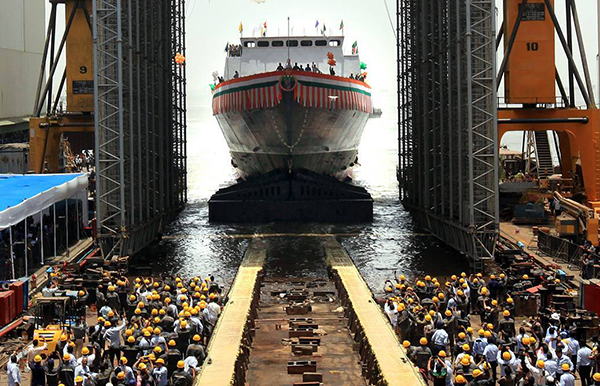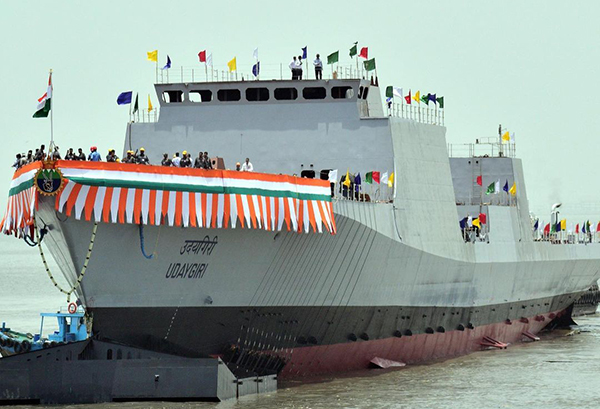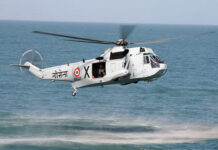Two indigenously built frontline indigenous warships of the Indian Navy – Surat, a Project 15B destroyer, and Udaygiri, a Project 17A frigate – were launched on 17 May 2022 at Mazagon Docks in Mumbai by defence minister Rajnath Singh.
The launch of a ship refers to it entering water for the first time. The process is carried out in tandem with the rising and receding tides. The next step after launch involves outfitting inside the ship, which is followed by sea trials. Once trials are done, a ship is commissioned.
Both 15B and P17A ships have been designed in-house by the Directorate of Naval Design, the fountainhead for all warship design activities in India, and during their building phase at the shipyard, around 75 per cent of the equipment and systems were sourced from indigenous firms including micro, small and medium enterprises, the statement added.
Defence Minister’s Speech
The defence minister, in his address after the launch, termed the two warships as “shining examples” of India’s growing indigenous capability. “These warships will be among the most technologically advanced missile carriers in the world that will cater to the present as well as future requirements,” he said.
After the concurrent launch of Surat and Udaygiri, Rajnath Singh said the two warships will add might to the Indian Navy’s arsenal and represent to the world India’s power of self-reliance. He exuded confidence that India will not only cater to its shipbuilding needs but also others in the coming days.
Singh said the ever-evolving security scenario in the Indian Ocean and the Indo-Pacific region demands a more important role for the Indian Navy in the times to come.
“The Indo-Pacific region is important for the economy of the whole world. India is a responsible maritime stakeholder in the region. We support consensus-based principles and peaceful, open, rule-based and stable maritime order. Being an important country in this region, it is the primary objective of our Navy to keep the Indo-Pacific open, safe and secure,” he said.
Project 15B Ships
The Project 15B class of ships are the next-generation stealth, guided missile destroyers of the Navy being built at Mazagon Docks. Surat is the fourth of Project 15B destroyers. It heralds a significant makeover of the P15A (Kolkata Class) destroyers and is named after the commercial capital of Gujarat and also the second-largest commercial hub of western India, after Mumbai. Surat has a rich maritime and ship building history and vessels built at the city in the 16th and 18th centuries were known for their longevity (of more than 100 years).
The warship Surat has been built using the block construction method, which involved hull construction at two different geographical locations. The first ship of this class was commissioned in 2021. The second and third ships have been launched and are at different stages of outfitting or trials.
Following its traditions and policy guidelines, the Indian Navy has named the destroyer Surat after the commercial capital of Gujarat, which is famous for its rich maritime and shipbuilding history.
Surat is the fourth and last ship of the Indian Navy’s Project 15B guided missile destroyers. The Rs 35,000-crore project is a follow-up programme of Project 15, which was launched in the 1990s to add guided missile destroyers to the inventory of the Indian Navy. It came to be known as the Delhi-class and was followed by Project 15A or Kolkata-class which focused on advanced technology and equipment.
Project 15B or Vishakhapatnam-class, was launched to add four stealth guided-missile destroyers and was envisaged to incorporate technological advancements in the naval ships. The P-15B destroyers were to incorporate new design concepts for improved survivability, sea keeping, stealth and manoeuvrability.
In a statement earlier, the Indian Navy said enhanced stealth features were achieved through the shaping of hull and the use of radar transparent deck fittings which made these ships difficult to detect. On their special features, it said that ships of the P-15B programme will have state-of-the-art weapons and sensors, including a vertically launched missile system for long-distance engagement of shore and sea-based targets. These ships will be equipped to carry and operate two multiple role helicopters, it added.
The first ship of this class, INS Visakhapatnam, was commissioned in 2021. The other two—Mormugao and Imphal—have been launched but not commissioned yet. All three, including Surat, are likely to be commissioned between 2023 and 2025.
Project 17A Ships
Udaygiri, named after a mountain range in Andhra Pradesh, is the third of Project 17A frigates. They have improved stealth features, advanced weapons and sensors and platform management systems. Udaygiri is the reincarnation of the erstwhile Udaygiri, the Leander Class ASW frigate, which saw numerous challenging operations in its illustrious service to the country spanning over three decades from February 18, 1976 to August 24, 2007. Under the P17A programme, a total of seven ships are under construction–four at Mazagon Docks and three at Kolkata’s Garden Reach Shipbuilders and Engineers.
Various novel concepts and technologies like integrated construction, mega block outsourcing, project data management/project lifecycle management etc have been adopted for the first time in indigenous warship design and construction.
The first two ships of P17A Project were launched in 2019 and 2020 at Mazagon Docks and Garden Reach Shipbuilders and Engineers respectively.
Frigates are named after mountain ranges. The ship Udaygiri gets its name from a mountain range in Andhra Pradesh.
Udaygiri, is the third stealth frigate of the P-17A class. The programme is a follow-up of Project 17 or Shivalik-class which was approved by the government in the late 1990s to build multi-role stealth frigates, a type of Naval warship that comes below a destroyer.
Project 17A or Nilgiri-class, with an estimated cost of ₹45,000 crore, was envisaged to build seven advanced guided missile frigates with an improved degree of stealth features, improved anti-air and surface war capabilities in the form of advanced weapons, sensors and platform management systems.
The Project 17A frigates are being fitted with weapons and sensors along with an integrated platform management system. The project is said to have cost around Rs 45,000 crores.
The ships to be built under Project 17A are listed with Yard Nos as under-
INS Nilgiri 12651
INS Himgiri 12652
INS Udaygiri 12623
INS Dunagiri 12654
INS Taragiri 3022
INS Vindhyagiri 3023
INS Mahendragiri 3024
Characteristics. Project 17A frigates are 149m long and 17.8m wide. The ships are powered by two MAN Diesel 12V28/33D STC engine producing 6000 KW of power each and two General Electric LM2500 marine gas engine producing maximum power of 25060 KW.
The ship are equipped with EL/M-2248 MF-STAR S-band multifunctional radar developed by IAI ELTA, BEL HUMSA-NG bow sonar, and Ajanta Electronic warfare system.
Project 17A class frigate can accommodate two medium-sized helicopters such as HAL Dhruv or Sea king MK 42B.
Armament. Each Project 17A frigate will be equipped with 32 Barack and 8 Brahmos Surface to air missiles and these missiles will be fired from a vertical launch system. Each frigate will be fitted with one BAE 5 Inch 62 Calibre MK-45 Naval gun and two AK-630 M Close-in weapon system. Two RBU-6000 ASW rocket launchers will be fitted onboard the frigates for anti-submarine warfare.
Indigenous Projects
Falling in line with the government’s Atmanirbhar (self-reliance) push to cut down on defence imports, the Indian Navy’s efforts to indigenise its equipment and systems started early. In 2014, it implemented the Indigenisation Plan (INIP) 2015-2030 for indigenous development of its resources. It further ramped up its efforts with a focus on weapons and aviation-related equipment. As of April 2022, 39 of the 41 ships and submarines that were under construction were being built in Indian shipyards.



















